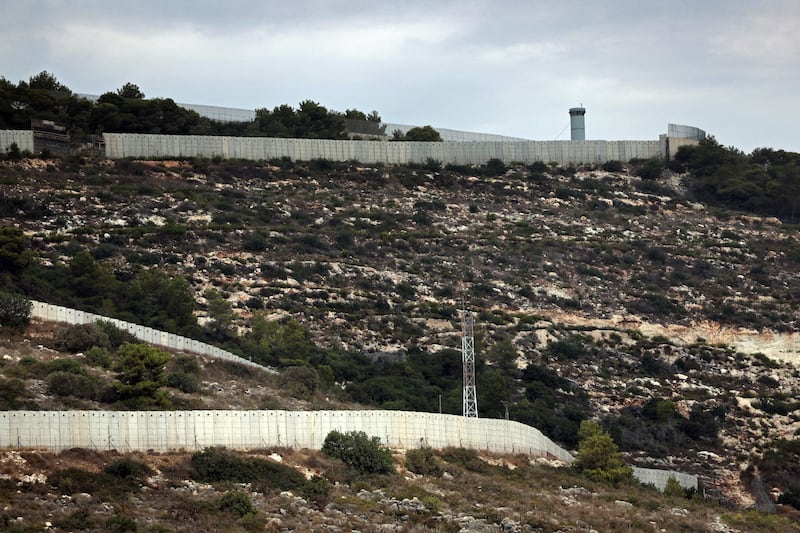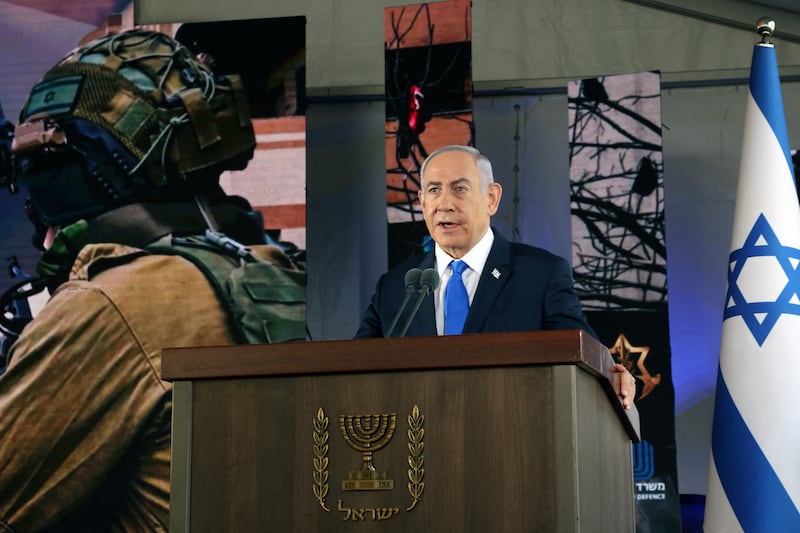
For several years now the Israeli army worked plate by plate on an ambitious project: an enormous, seven-meter-high concrete wall to protect the villages on the northern border against Hezbollah militants in Lebanon.
The wall, which would one day extend across much of the 130 km long border, fit neatly into Israel’s containment strategy. Along with reinforced barriers around the Gaza Stripin the West Bankalong the occupied one Golan Heights and the Egyptian border, the idea was to keep enemies out and strengthen Israelis’ sense of security.
But in the year after that Hamas broke through the Gaza barrier to launch his country October 7 attackthe Lebanon Wall – like Israeli doctrine – has become a relic. Across the Middle East, Israel now sees an opportunity to take on its enemies and try to impose a new order: which prime minister Benjamin Netanyahu calls for a “strategic turn” to “change the security reality in our region for generations to come.”
The imposing wall has now been pierced with holes to allow Israeli troops to enter the battlefields of southern Lebanon.
“Israel is no longer passive, we are active, we initiate and will initiate in the future – preventive wars are no longer a sin,” said Yaakov Amidror, a retired Israeli general at the Washington-based Jewish Institute for National Security of the American think tank . “We will prevent any attempt by our enemies to be the monster on our borders.”
 The Israeli defensive wall between Israel and Lebanon in Rosh HaNiqra, northern Israel. Photo: Thomas Coex/AFP via Getty Images
The Israeli defensive wall between Israel and Lebanon in Rosh HaNiqra, northern Israel. Photo: Thomas Coex/AFP via Getty Images
The battlefield gains have boosted Israel’s confidence and strengthened its sense of military superiority, as the initial war objectives of eliminating Hamas and freeing hostages held in Gaza turned into a multi-front conflict against Iran and its allies.
Netanyahu, who was considered risk-averse before the Hamas attack, told the Knesset last week that Israel’s strategy was to destroy Iran’s so-called resistance axis, where Hezbollah, Hamas, Houthis in Yemen and Shia militias in Iraq and Syria, all of which have fired on Israel in the past year.
Netanyahu cited Israel’s attack on Iranian military targets last month — retaliation for an Iranian missile barrage on Israel — as an example of this “strategic turn.” It was the first time Israeli forces acknowledged a direct attack on their arch-enemy, and followed a month of intense Israeli military activity across the region.
( Investigations into the fatal shooting of an Irish soldier in Lebanon will be reported next yearOpens in a new window )
After a year of cross-border fire, Israel dramatically expanded its offensive against Hezbollah, pounding targets across Lebanon and launching the first land invasion of its northern neighbor in nearly two decades. Israeli forces also launched a brutal new offensive in northern Gaza in recent weeks, launching airstrikes in Syria and bombing Houthi targets in Yemen.
The thinking in Israel is that by severely humiliating Hamas and Hezbollah, it has weakened the Islamic Republic’s frontline defense against the Jewish state.
 Israeli Prime Minister Binyamin Netanyahu, who was considered risk-averse before the Hamas attack, has said Israel’s strategy was to “dismantle” Iran’s “resistance axis.” Photo: Gil Cohen-Magen/AFP via Getty Images
Israeli Prime Minister Binyamin Netanyahu, who was considered risk-averse before the Hamas attack, has said Israel’s strategy was to “dismantle” Iran’s “resistance axis.” Photo: Gil Cohen-Magen/AFP via Getty Images
Amir Avivi, a retired general and founder of the Israel Defense and Security Forum, said Israel “understands that we have a historic opportunity to not only eradicate Hamas, but also dismantle Hezbollah” and attack Iran.
“Iran has lost its strategic depth… and now is the time to really take them out of the equation,” said Avivi, who is close to the far-right government. “When (Netanyahu) talks about total victory today, it is about really crushing the Shia axis.”
He predicted a “long campaign”. “It will not stop until this (Iranian) regime is on its knees, just like Hezbollah,” Avivi said.
One critical question is whether Israel will attempt to attack Iran’s nuclear sites, with Netanyahu saying last week that the “highest goal” of Israeli security services was to prevent Iran from obtaining a nuclear weapon.
We understand that we have a unique opportunity: we have superiority over Hezbollah. They can’t resist
Avivi said Israel’s prediction was that a cornered Iran would weaponize its program. “Either they go nuclear or we destroy them,” he said.
Experts have long said that Israel would need U.S. help to seriously damage the republic’s nuclear facilities, but the Oct. 26 direct strikes on Iran, consisting of about 100 Israeli fighter jets and tankers, may have demonstrated greater capabilities than previously thought.
( Israeli airstrikes kill at least 30 Palestinians in Gaza, doctors sayOpens in a new window )
“They were just able to carry out this long-range attack without our tankers,” said a former US defense official. “They still need heavy bombs, but if the airspace is not contested (over Iran), the Israelis might be able to get a few punches in.”
The sense of military ascendancy also shapes Israel’s approach to the US-led diplomatic efforts to end the conflicts in Gaza and Lebanon.
Netanyahu refuses to give in to Hamas demands to agree a permanent ceasefire and withdraw Israeli troops from Gaza to secure the release of hostages. And he insists that Israel retains the right to unilaterally enforce any agreement that would result in Hezbollah’s withdrawal from southern Lebanon.
“We understand that we have a unique opportunity: we have superiority over Hezbollah. They can’t resist,” Defense Minister Yoav Gallant told the Financial Times. “Their ability to defend themselves in southern Lebanon is collapsing. Unlike (in the last war) in 2006, Israel’s military performance today puts us in a strong position to demand that Hezbollah reduce its forces.”
There are also signs that Syria, where Iranian forces and Hezbollah fighters have been deployed to support Bashar al-Assad’s regime during Syria’s civil war, is in Israel’s crosshairs. Israel, which has long carried out sporadic attacks on targets linked to Iran and Hezbollah, has increased its attacks in the past year.
( Four were detained for information theft from the Israeli armyOpens in a new window )
“We cannot accept the Iranian military in Syria,” Gallant said. “We must stop the transfer of weapons, especially powerful weapons, from Iran through Syria and Iraq to Lebanon.”
Israel’s military offensives have reshaped the region, with devastating consequences for millions of Palestinians and Lebanese. Much of Gaza has become uninhabitable, while more than 90 percent of the Gaza Strip’s 2.3 million residents have been driven from their homes.
More than a million people have also been displaced in Lebanon as Israel’s relentless bombing destroys parts of the south and the eastern Beqaa Valley.
Michael Wahid Hanna, U.S. program director at the Crisis Group think tank, said the Middle East appears to be in a “new, open phase of regionalized conflict” as Israel “senses an opportunity” to reshape the region to its liking.
The costs to Israel were “manageable” in terms of casualties and reputation, Hanna added, despite “some parts of the world viewing them as some kind of rogue state.”
“As long as they have the full support of the US and much of Europe, they can get away with it,” Hanna said. But “the brutality of the war and the trend of public opinion will mean that Arab relations remain largely very cold.”
One question that remains largely unresolved by Israeli leaders, however, is what will come next, and when.
Amidror, who is close to Netanyahu, said he expected Israel to continue fighting in Gaza throughout the year to “cleanse” the strip “of all (Hamas) remnants.”
Netanyahu insists that Israel will maintain overall security control over Gaza with or without a ceasefire.
Amidror said the dynamic would be similar to areas of the West Bank nominally under Palestinian rule, where Israeli forces attack suspected militants at will. He also predicted that Israel would continue to attack Hezbollah targets in Lebanon.
Asked about the risks of perpetual conflict, Amidror said: “We don’t buy these stories anymore. It is the same story we were told inside and outside Israel before October 7.”
Still other Israelis worry that their country is on the path to endless war, without a clear strategy on how to translate battlefield successes into lasting political gains, as they battle ideological enemies that exist even in their weakened state will continue to exist.
“Victory or winning, I’m not sure you can even use those terms in reference to this war,” said Michael Milshtein, a former Israeli intelligence officer. “This is the hardest part: every day we see military achievements, killing (Hamas leader Yahya) Sinwar, destroying Hezbollah (infrastructure), but when will we see the end? When can we plan something?”
– Copyright The Financial Times Limited 2024